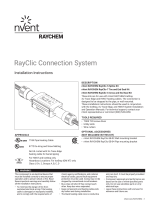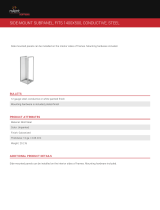
20
|
nVent.com/RAYCHEM
EN
CF
Garantie
nVent garantit tous les systèmes de treillis WinterGuard nVent RAYCHEM contre les défauts de fabrication et l’utilisation de matériaux
défectueux pendant deux (2) ans à compter de la date d’achat. Cette garantie ne peut être modifiée que par un document écrit signé par un
agent dûment autorisé de nVent. Le seul recours de l’acheteur en vertu de cette garantie consiste à ce que nVent, dans un délai raisonnable,
répare le produit ou fournisse un produit de remplacement ou encore crédite le compte de l’acheteur pour ledit produit et en accepte le
retour, selon l’éventualité retenue par nVent et ce, à sa seule discrétion. nVent ne doit en aucun cas être tenue responsable du coût de la
dépose ou de l’installation, de tout dommage ou perte de jouissance des lieux ou de toute autre propriété, de toute perte de revenu, de
toute perte de l’utilisation des revenus, de la perte de profits anticipés ou de tout dommage ou coût de quelque nature que ce soit, qu’il
s’agisse de dommages directs, indirects, accessoires ou consécutifs. En dépit de ce qui précède, nVent n’assume aucune responsabilité à
moins que: (a) L’acheteur avise rapidement nVent par écrit après avoir découvert toute non-conformité présumée et fournit une explication
détaillée de ladite non-conformité présumée; (b) l’acheteur retourne sans tarder les produits à l’attention de nVent, port payé, à l’adresse
suivante: 250 West Street, Trenton, Ontario, K8V 5S2, Canada ou 7433 Harwin Drive, Houston, Texas, 77036, USA; et (c) l’examen effectué
par nVent desdits produits établit, à la satisfaction de nVent, que les non-conformités présumées existent réellement et sont survenues
suite à l’utilisation normale du produit, non pas suite à un accident, à une mauvaise utilisation, à de la négligence, à une modification, une
réparation ou une vérification ou toute autre cause ne relevant pas du champ de responsabilité de nVent en vertu de la présente garantie
limitée. LA PRÉSENTE GARANTIE TIENT LIEU DE TOUTE REPRÉSENTATION, GARANTIE OU CONDITIONS, EXPRESSES OU IMPLICITES,
Y COMPRIS, SANS TOUTEFOIS S’Y LIMITER, TOUTE GARANTIE IMPLICITE DE QUALITÉ MARCHANDE, À LA CONFORMITÉ À UN USAGE
PARTICULIER ET À L'ABSENCE D'INFRACTIONS, AINSI QUE TOUTE AUTRE OBLIGATION OU RESPONSABILITÉ DE LA PART DE nVent, QUE
CE SOIT PAR RÈGLEMENT, CONTRAT, RESPONSABILITÉ STRICTE, DÉLIT OU AUTREMENT. Si les produits sont considérés comme un produit
de consommation dans la juridiction de l’acheteur, les exclusions et limitations décrites ci-haut en lien avec les dommages accessoires ou
indirects, ainsi que la clause de non-responsabilité des garanties implicites, peuvent ne pas s’appliquer. Les modalités d’une telle garantie
implicite sont limitées aux modalités de la présente garantie de deux (2) ans. Certaines juridictions ne permettent pas de limitation sur la
durée d’une garantie implicite, dans de tels cas, ces limites peuvent ne pas s’appliquer à vous. Cette garantie donne au consommateur des
droits légaux spécifiques et ce dernier peut avoir d’autres droits, lesquels peuvent différer selon la juridiction.
Numéros de catalogue du treillis WinterGard
Le numéro de catalogue du treillis WinterGard encode les caractéristiques du produit comme suit:
WM[a]-[bb][cc]
• WM = treillis WinterGard
• [a] = tension
o 1 = 120 V
o 2 = 240 V
• [bb] = largeur (pi)
o 02 = 2pi
o 03 = 3pi
• [cc] = longueur (pi)
o 05 = 5pi
o 10 = 10pi
o 15 = 15pi
o 20 = 20pi
o 25 = 25pi
o 30 = 30pi
o 35 = 35pi
o 40 = 40pi
o 45 = 45pi
o 50 = 50pi
o 60 = 60pi
• Surface de couverture (pi2) = largeur x longueur
• Puissance (W) = surface de couverture (pi2) x 50 larg./pi2
Par exemple, WM1-0205 est de 120 V, 2pi de large, 5pi de long, surface de 10 pi2 et 500 W.
























